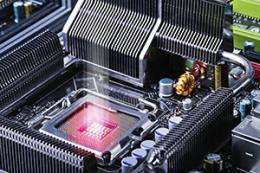Data storage: Nanoscale memory device uses freely moving mechanical shuttle to improve performance

A loose and rattling part in your cell phone is generally a cause for concern. Like most other electronic devices, your phone works by moving electrons through fixed circuit pathways. If electrons are not sufficiently contained within these pathways, the efficiency and speed of a device decrease. However, as the miniature components inside electronic devices shrink with each generation, electrons become harder to contain. Now, a research team led by Vincent Pott at the A*STAR Institute of Microelectronics, Singapore, has designed a memory device using a loose and moving part that actually enhances performance.
The loose part is a tiny metal disk, or shuttle, about 300 nanometers thick and 2 micrometers long, and lies inside a roughly cylindrical metal cage. Because the shuttle is so small, gravity has little effect on it. Instead, the forces of adhesion between the shuttle and its metal cage determine its position. When stuck to the top of its cage, the shuttle completes an electrical circuit between two electrodes, causing current to flow. When it is at the bottom of the cage, the circuit is broken and no current flows. The shuttle can be moved from top to bottom by applying a voltage to a third electrode, known as a gate, underneath the cage.
Pott and co-workers suggested using this binary positioning to encode digital information. They predicted that the forces of adhesion would keep the shuttle in place even when the power is off, allowing the memory device to retain information for long periods of time. In fact, the researchers found that high temperature—one of the classic causes of electronic memory loss—should actually increase the duration of data retention by softening the metal that makes up the shuttle memory's disk and cage, thereby strengthening adhesion. The ability to operate in hot environments is a key requirement for military and aerospace applications.
The untethered shuttle also takes up less area than other designs and is not expected to suffer from mechanical fatigue because it avoids the use of components that need to bend or flex—such as the cantilevers used in competing mechanical memory approaches. In a simulation, Pott and co-workers found that the shuttle memory should be able to switch at speeds in excess of 1 megahertz.
The next steps, the researchers say, include designing arrays of the devices and analyzing fabrication parameters in detail. If all goes well, their novel device could compete head-to-head with the industry-standard FLASH memory.
More information: Pott, V., Li, C. G., Vaddi, R., Tsai, J. M.-L. & Kim, T. T. The shuttle nanoelectromechanical nonvolatile memory. IEEE Transactions on Electron Devices 59, 1137–1143 (2012). ieeexplore.ieee.org/xpl/login. … tp=&arnumber=6135495



















